DIFFRACTION GRATINGS I F THE NUMBER OF SLITS IN
10102018 THE DIFFRACTION GRATING TO MEASURE THE WAVELENGTH OF12 CRYSTALLOGRAPHYDIFFRACTION METHODS TEXTS DR ALLEN D HUNTER YOUNGSTOWN
ADVANCED POWDER DIFFRACTION ARE YOU GETTING EVERYTHING YOU CAN
APPLIED MODERN PHYSICS I XRAY DIFFRACTION TOPOGRAPHY AND
CHAPTER 35 INTERFERENCE AND DIFFRACTION CHAPTER 35 INTERFERENCE AND
CRYSTALLOGRAPHY AND DIFFRACTION COURSE ID CHEM 18 (3 CR)
Diffraction grating
Diffraction gratings
I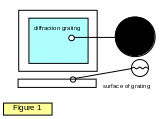 f
the number of slits in an obstacle is now increased we will see that
the sharpness of the pattern is improved, the maxima getting
narrower. Obstacles with a large number of slits (more than, say, 20
to the millimetre) are called diffraction gratings. These were first
developed by Fraunhofer in the late eighteenth century and they
consisted of fine silver wire wound on two parallel screws giving
about 30 obstacles to the millimetre.
f
the number of slits in an obstacle is now increased we will see that
the sharpness of the pattern is improved, the maxima getting
narrower. Obstacles with a large number of slits (more than, say, 20
to the millimetre) are called diffraction gratings. These were first
developed by Fraunhofer in the late eighteenth century and they
consisted of fine silver wire wound on two parallel screws giving
about 30 obstacles to the millimetre.
Since then many improvements have been made, in 1882 Rowland used a diamond to rule fine lines on glass, the ridges acting as the slits and the rulings as the obstacles (Figure 1). Using this method it is possible to obtain diffraction gratings with as many as 3000 lines per millimetre although 'coarse' gratings with about 500 lines per millimetre are better for general use.
In many schools two types are in common use, one with 300 lines per mm and the other with 80 lines per mm.
Reflection gratings are also used, where the diffracted image is viewed after reflection from a ruled surface. A very good example of a reflection diffraction grating is a CD. A DVD with finer rulings gives a much broader diffraction pattern.
The wave theory and the diffraction grating

Figure 2 shows the Huygens construction for a grating. You can see how the circular diffracted waves from each slit add together in certain directions to give a diffracted wave which has a plane wave front just like the waves hitting the grating from the left. This plane wave is formed by drawing the line that meets all the small circular waves and is called an envelope of all these small secondary waves.
T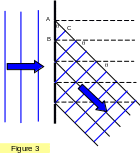 he
diffraction grating formula
he
diffraction grating formula
Consider a parallel beam of light incident normally on a diffraction grating with a grating spacing e (the grating spacing is the inverse of the number of lines per unit length). Consider light that is diffracted at an angle to the normal and coming from corresponding points on adjacent slits (Figure 3).
F
Diffraction
grating maximum m
= e
sin
where
m = 0,
1, 2,3...
But AC = e sin. Therefore for a maximum:
The number m is known as the order of the spectrum, that is, a first-order spectrum is formed for m = 1, and so on.
If light of a single wavelength, such as that from a laser, is used, then a series of sharp lines occur, one line to each order of the spectrum. With a white light source a series of spectra is formed with the light of the shortest wavelength having the smallest angle of diffraction.
In deriving the formula above, we assumed that the incident beam is at right angles to the face of the grating. Allowance must be made if this is not the case. The simplest way is to measure the position of the first order spectrum on either side of the centre, record the angle between these positions and then halve it, as shown in Figure 4.
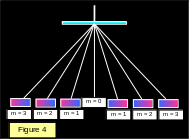
The number of orders of spectra visible with a given grating depends on the grating spacing, more spectra being visible with coarser gratings. The ruled face of the grating should always point away from the incident light to prevent errors due to changes of direction because of refraction in the glass. The diagram shows a central white fringe with three spectra on either side giving a total of seven images.
(See example problem )
Example
problems 1.
Calculate the wavelength of the monochromatic light where the second
order image is diffracted through an angle of 25o
using a diffraction grating with 300 lines per millimetre. Grating
spacing (e) = 10-3/300
m = 3.3x10-6
m Wavelength
()
= esin25/2 = [3.3x10-6
x 0.42]/2 = 6.97 x 10-7
m = 697 nm 2.
Calculate the maximum number of orders visible with a diffraction
grating of 500 lines per millimetre, using light of wavelength 600
nm. Maximum
angle of diffraction = 90o
e = 10-3/500
= 2x10-6
m Therefore
m = esin/
= 2x10-6/600x10-9
= 3.33 Therefore
maximum number of orders = 3, and a total of seven images of the
source can be seen (three on each side of a central image).
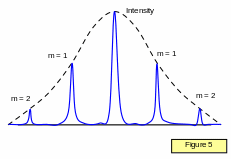
The intensity distribution for a large number of slits is shown in Figure 5. Notice that the maxima become much sharper; the greater the number of slits per metre, the better defined are the maxima.
Student
investigation The
diffraction of cadmium or mercury light is used to determine the
separation of two lines on an integrated circuit. The following
results were obtained for the second order diffracted images for
different wavelengths. Use them to plot an appropriate linear graph
and thence determine the mean spacing of the wires on the circuit. Wavelength/nm
Angle of diffraction (o) 468 28.0 480 28.7 509 31.0 546 33.0
577 35.5
644 40.0
CSSP DIFFRACTION SIMULATOR VERSION 33 SHAREWARE SOFTWARE TOOL FOR
DIFFRACTION TAKING LIGHT APART TEACHER GUIDE THIS SUITE
DIFFRACTION AT BIRD FEATHER TATJANA SAPTSINA TNSFIANSMRRU LEBEDEV
Tags: diffraction gratings, of diffraction, gratings, number, slits, diffraction
- DATE DEAR PARENTGUARDIAN THIS LETTER IS TO LET YOU
- INTRODUCCIÓ A LA COMPTABILITAT GENERAL PROGRAMA INTRODUCCIÓ A LA
- WODZISŁAW ŚLĄSKI DNIA ………………………… ……………………………………………………… (IMIĘ I NAZWISKO) ………………………………………………………
- NAME HOUR DATE CHEMISTRY PERCENTAGE COMPOSITION
- PRŮVODNÍ DOPIS K ŽALOBNÍMU NÁVRHU V PŘÍLOZE JE ŽALOBNÍ
- DOCUMENTS TO BE SUBMITTED FOR APPLICATION AS A “QUALIFIED
- TURINYS I TEOSOFIJA IR TEOSOFINĖ DRAUGIJA PAVADINIMO PRASMĖ TEOSOFINĖS
- ELTHAM COPPER BUTTERFLY PARALUCIA PYRODISCUS LUCIDA ELTHAM COPPER
- LEGIONOWO … (STOPIEŃ IMIĘ I NAZWISKO) … (SYMBOL
- ASOCIATIA GRUP LOCAL PENTRU PESCARIE DURABILA IN DELTA DUNARII
- ……………………………………………… IMIĘ I NAZWISKO OŚWIADCZENIE OŚWIADCZAM ŻE POSIADAM PEŁNĄ
- PROBLEMAS QUE AFECTAN LA CALIDAD DEL PROCESO DE ENSEÑANZA
- PARIS JULY 2010 CALL FOR SPONSORING FOLLOWING THE SUCCESS
- SERIE NORMATIVAS INSTRUCCIONES DE CONSTRUCCIÓN JULIO 2009 ÍNDICE 1
- BERANGOKO UDALA PARA EL DÍA 4 DE OCTUBRE ESTÁ
- EXTRACTING OIL FROM NUTS STUDENTS’ SHEET IN THIS
- ACUERDO DE COLABORACIÓN PARA LA GESTIÓN Y EJECUCIÓN DEL
- HOJA DE INSCRIPCIÓN ESCUELA DE SEMANA SANTA 2019 DATOS
- ALEXANDER VON HUMBOLDT SU ESTANCIA EN ESPAÑA Y SU
- CLASSIFICATION OF LIVING THINGS NOTES 1 AN ORGANISM IS
- DARBO TEISE IVADAS DARBO SANTYKIU REGLAMENTAVIMAS DARBO ISTATYMU KODEKSU
- INTRODUCCION A LA IMPLEMENTACION DE CONTROLADORES PID ANALOGOS JUAN
- INTRODUCING CERIDIAN ONLINE PAY STATEMENTSTAX FORMS POWERED BY EPOST™
- Intervju g François Fillona Francuskog Premijera za Jutarnji List
- EL TIMÓN DE LA ENTREVISTA ESCUCHAR LOS QUE SOLEMOS
- QUESTIONS FOR PARENTS CHILD’S NAME DOB NAME
- 5 FRANÇAIS ONTARIO REGULATION 18519 MADE UNDER THE OCCUPATIONAL
- DIRECTORIO DE CANCHAS TORNEO ACB 2015 ORGANIZADORES DEL TORNEO
- RL FACILITY REPRESENTATIVE PROGRAM MARCH 15 1995 SURVEILLANCE GUIDELINE
- M 7500 REV 0 OBERLANDESGERICHT TRIENT AUSSENSTELLE BOZEN ORDENTLICHE
METODICKÝ POKYN MINISTERSTVA SPRAVEDLNOSTI ČESKÉ REPUBLIKY ZE DNE 20
TITLE ACTUARIAL METHODS LECTURE HOURS LECTURE 15H CLASSES 15H
EMBASSY OF THE ARGENTINE REPUBLIC TO FEDERAL REPUBLIC OF
WYKAZ KANDYDATÓW SPEŁNIAJĄCYCH WYMAGANIA FORMALNE OKREŚLONE W OGŁOSZENIU O
ZAŁĄCZNIK NR 1 SERWIS POGWARANCYJNY PRZEŁĄCZNIKÓW SAN ŚRODOWISKA MAINFRAME
 13 FROM PLI’S COURSE HANDBOOK CONDUCTING DUE DILIGENCE IN
13 FROM PLI’S COURSE HANDBOOK CONDUCTING DUE DILIGENCE IN ROTARY ECLUB PUERTO RICO Y LAS AMÉRICAS
ROTARY ECLUB PUERTO RICO Y LAS AMÉRICAS 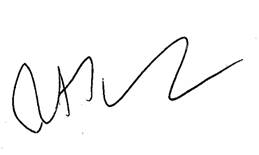 BOSTON BOROUGH COUNCIL NOTICE OF A GENERAL EXCEPTION TO
BOSTON BOROUGH COUNCIL NOTICE OF A GENERAL EXCEPTION TO DRISCOLL’S MODEL OF REFLECTION DRISCOLL J (2000) ‘PRACTISING CLINICAL
DRISCOLL’S MODEL OF REFLECTION DRISCOLL J (2000) ‘PRACTISING CLINICAL АГЕНТСТВО ЭКОНОМИЧЕСКОЙ ИНФОРМАЦИИ “ПРАЙМ” ® ФИНАНСОВЫЕ НОВОСТИ Ã ЕЖЕДНЕВНОЕ
АГЕНТСТВО ЭКОНОМИЧЕСКОЙ ИНФОРМАЦИИ “ПРАЙМ” ® ФИНАНСОВЫЕ НОВОСТИ Ã ЕЖЕДНЕВНОЕ0 NAZIV PROGRAMA MJERA SUZBIJANJA PATOGENIH MIKROORGANIZAMA ŠTETNIH ČLANKONOŽACA
SCHULJAHR 200809 KURSTHEMA „KUNST UND COMPUTER –
 5 NKPPO 2012 U RZĄD MIASTA URZĄD
5 NKPPO 2012 U RZĄD MIASTA URZĄD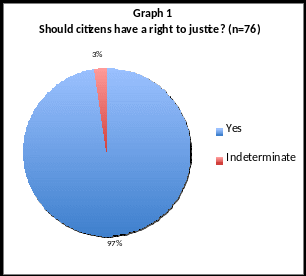 What is Access to Justice? Draft [tcwf] 20 September
What is Access to Justice? Draft [tcwf] 20 September INLAND EROSION HAZARD ASSESSMENT AND MAPPING FOR ANTIGUA BARBUDA
INLAND EROSION HAZARD ASSESSMENT AND MAPPING FOR ANTIGUA BARBUDAOŚWIADCZENIE O WYRAŻENIU ZGODY NA PRZETWARZANIE DANYCH OSOBOWYCH WŁASNYCH
 pr2017-107_att_3_df_v2.0
pr2017-107_att_3_df_v2.0 SAMPLE HOUSING REHABILITATION CHECKLIST ABOUT THIS CHECKLIST DESCRIPTION THE
SAMPLE HOUSING REHABILITATION CHECKLIST ABOUT THIS CHECKLIST DESCRIPTION THE COLEGIO SANTA MARÍA DE MAIPÚ DEPARTAMENTO DE CIENCIAS GUIA
COLEGIO SANTA MARÍA DE MAIPÚ DEPARTAMENTO DE CIENCIAS GUIA COMISIÓN NACIONAL DE ÁREAS NATURALES PROTEGIDAS CONVOCATORIA PÚBLICA Y
COMISIÓN NACIONAL DE ÁREAS NATURALES PROTEGIDAS CONVOCATORIA PÚBLICA Y